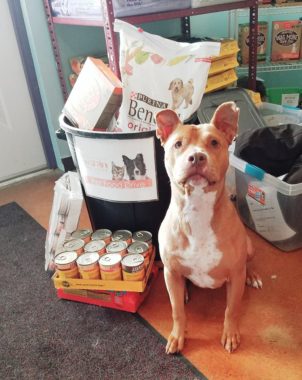Anyone who has ever welcomed a pet into their home understands the value that animals offer to their families. Many people assume that most pets are brought to shelters because of behavioral issues, family changes, allergies or simply due to their caregiver’s lack of understanding about what it takes to care for an animal. Pets certainly end up in shelters for these reasons, however, a startling number of pets end up in shelters because their heartbroken families cannot afford to care for them.
A Common Scenario
The sudden loss of a job, divorce, injury or death of a family member can all lead to financial havoc. During times of stress and grief, it’s the pets in our lives that can provide just the comfort and unconditional love that we need. Unfortunately, when faced with a crisis, many families are forced to make difficult choices, and the cost of feeding a dog or cat can become so overwhelming that families feel that they have no alternative but to turn to a shelter.
Fostering a pet, or finding a new permanent home are two options for pet owners who are unable to care for their pet, but in reality, shelters have far more resources than most families who are trying to re-home a pet and are better equipped at ensuring that each pet ends up in safe hands. It’s a devastating decision for most families. Fortunately, there is another option that is far less costly for shelters, and far less traumatizing for pets and their families.
The True Cost of Sheltering and Re-homing a Pet
Every time that an animal enters the shelter environment, no matter how healthy they are, there are specific costs incurred. Beyond intake vaccinations and medical exams and lab work, animals who reside in shelters often receive preventative treatments to avoid infection from parasites and illnesses that may result from many animals living in close proximity. All of the costs associated with sheltering and re-homing a pet quickly add up, especially when you consider factors such as the marketing required to find a new home, screening potential families and administrative fees.
Along with the financial cost, sheltered pets also pay a hefty emotional toll. Animal shelters do their best to care for pets, provide training, a comfortable place to sleep and to enrich their lives during a stay, but nothing replaces a home and family. If you have a pet, you’ve probably had to provide comfort at some point because of unexpected loud noises, changes around the house and other startling conditions that can be stressful for anyone! Imagine how often pets in new and confined spaces experience extreme stress. In some cases, this emotional cost translates into even more financial cost, when pets end up getting sick or on anti-anxiety medication.
A More Cost-Effective Alternative
Pet food can get pricey, but for just $4.00 a month, we can provide pet food for a family in need, while they work toward getting back on their feet. By partnering with “human” food banks, leveraging relationships with pet stores, pet food suppliers, corporate donors and other organizations while utilizing the resources of dedicated volunteers, our team is able to help thousands of struggling families to keep their pets at home.
Through outreach to those who might be considering taking their pet to a shelter, we can prevent pet homelessness, reduce pet shelter overcrowding and allow pets to continue to bring love and joy into their homes. It’s a great alternative and a realistic one, and it’s already making a huge impact on pets and their humans in Colorado. If you’d like to hear more about the benefits of keeping pets out of shelters or would like to learn how you can help, please contact us for more details.



 Happy New Year!
Happy New Year!